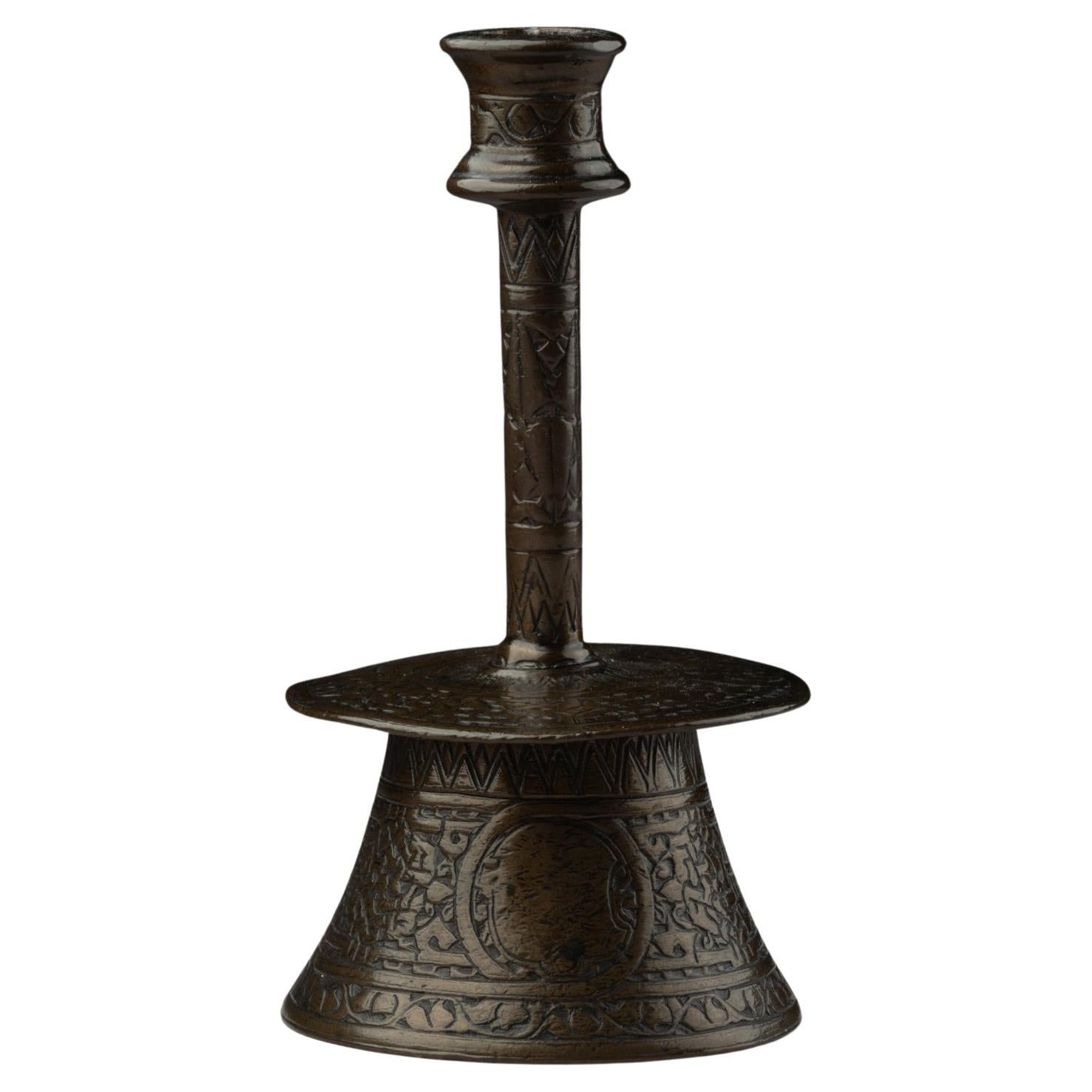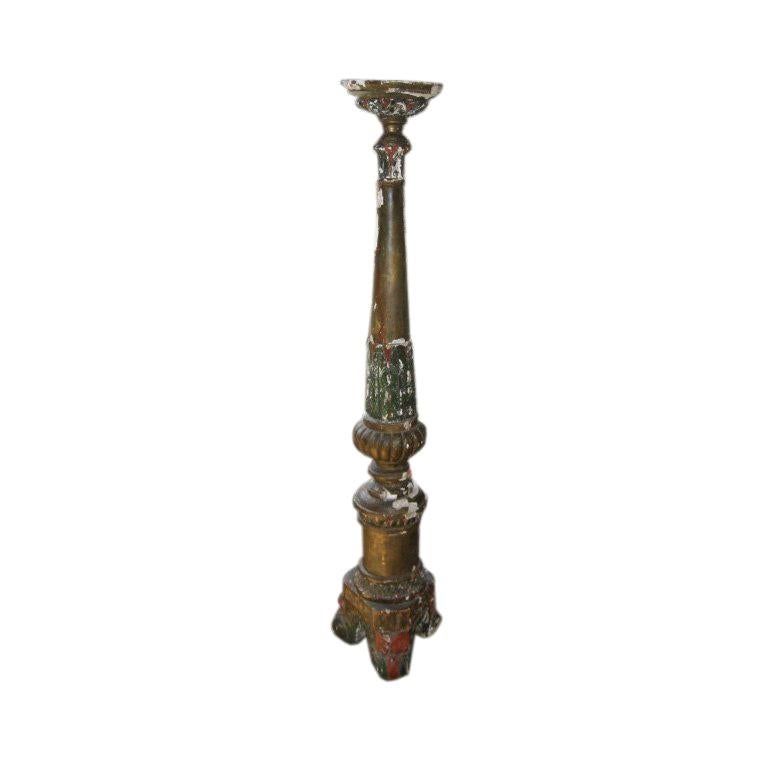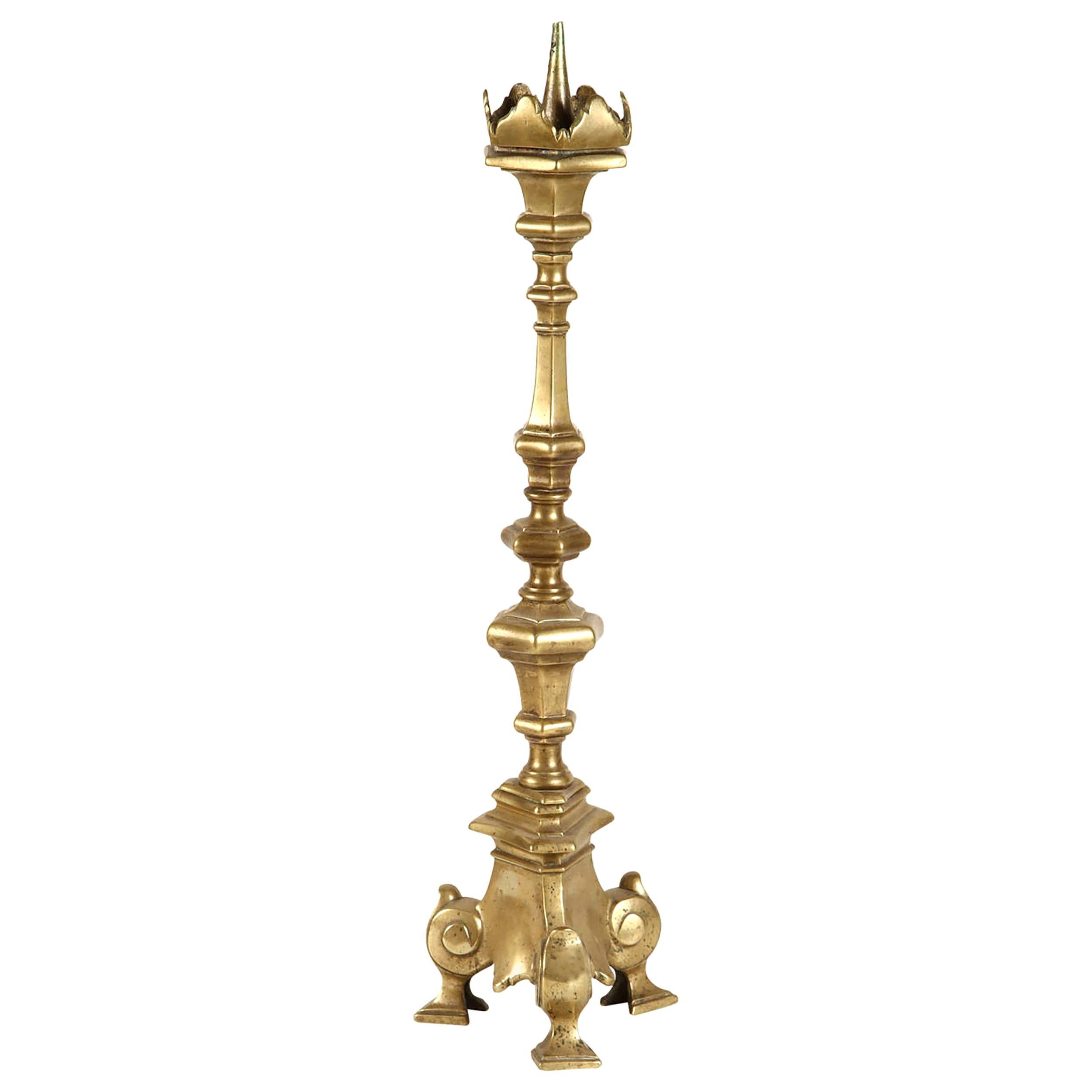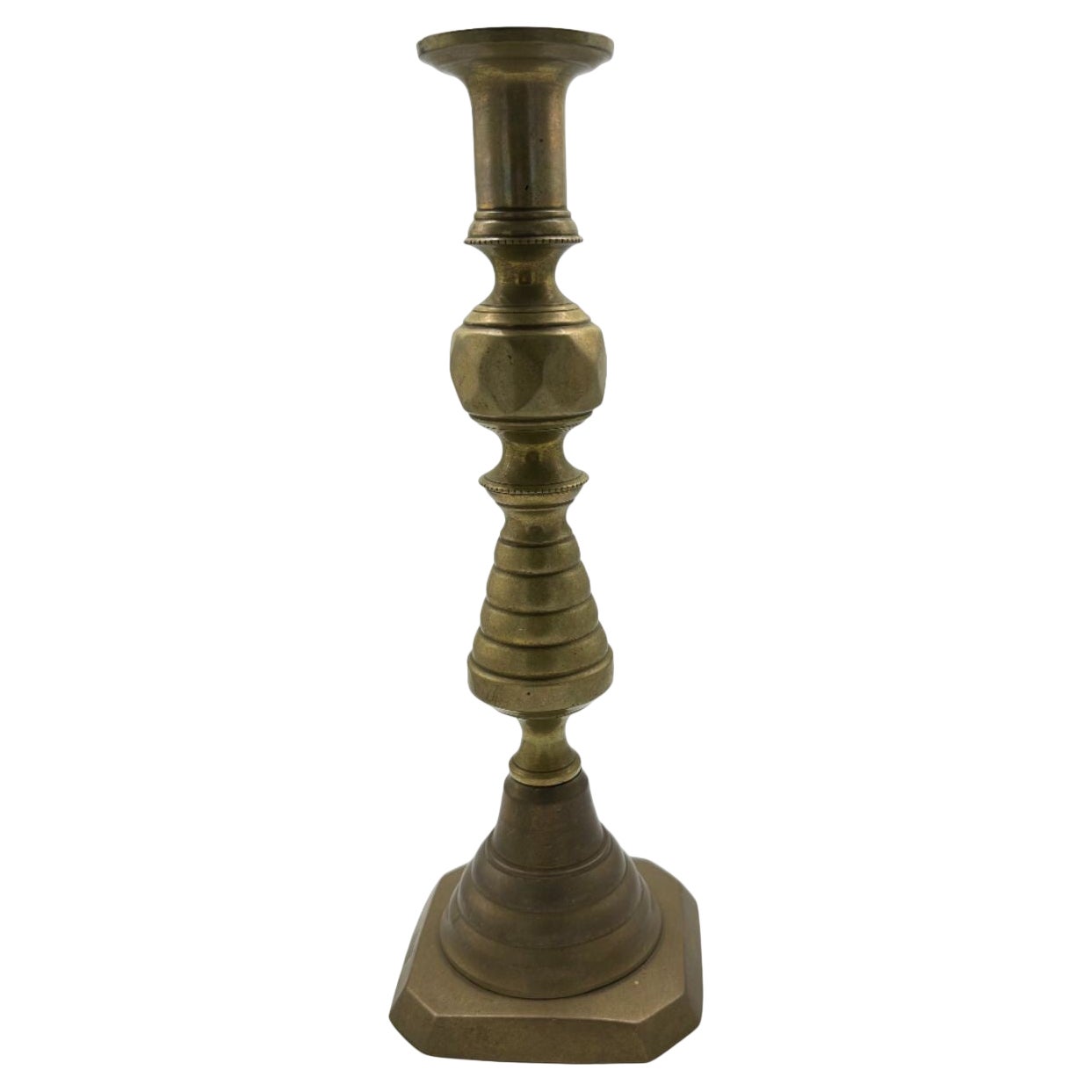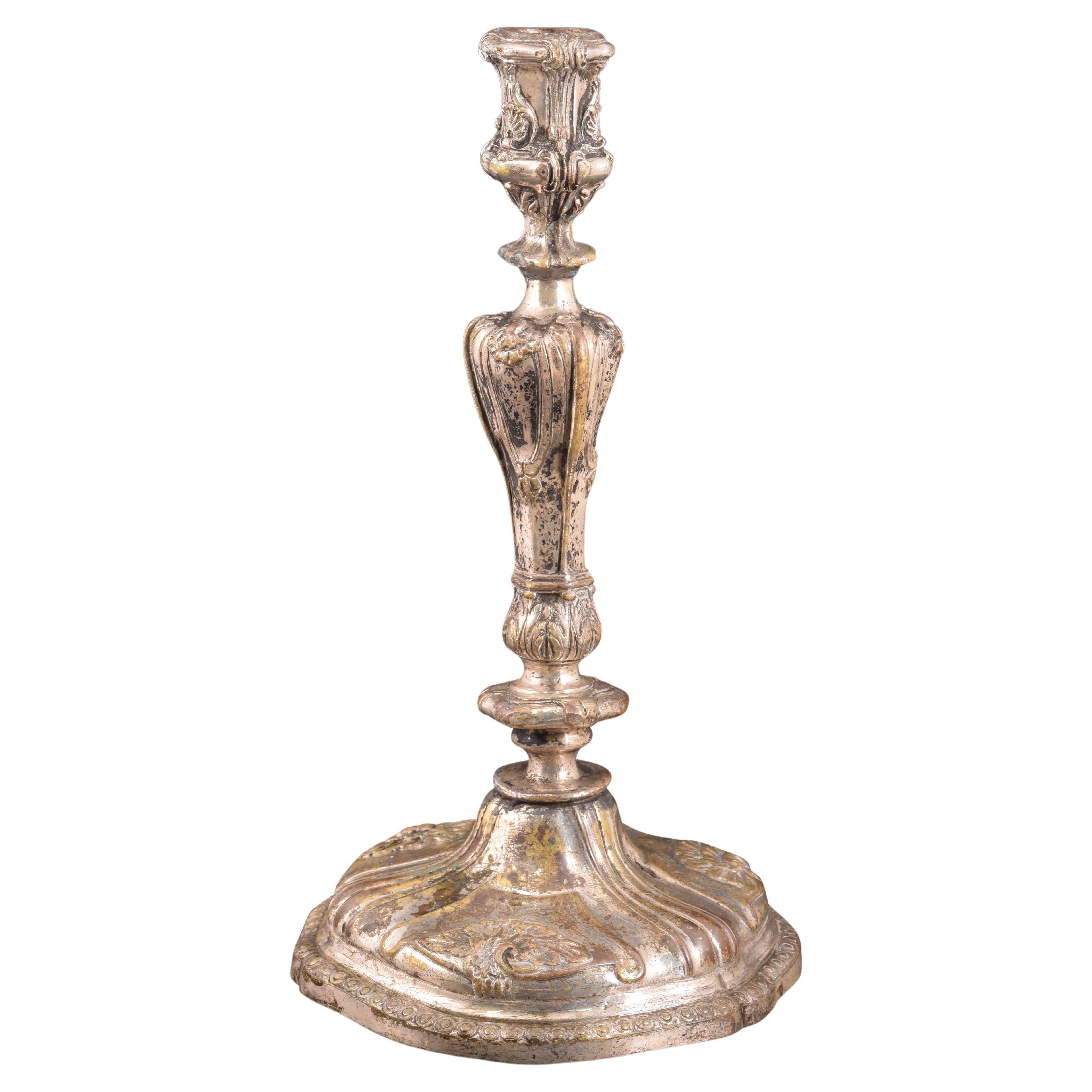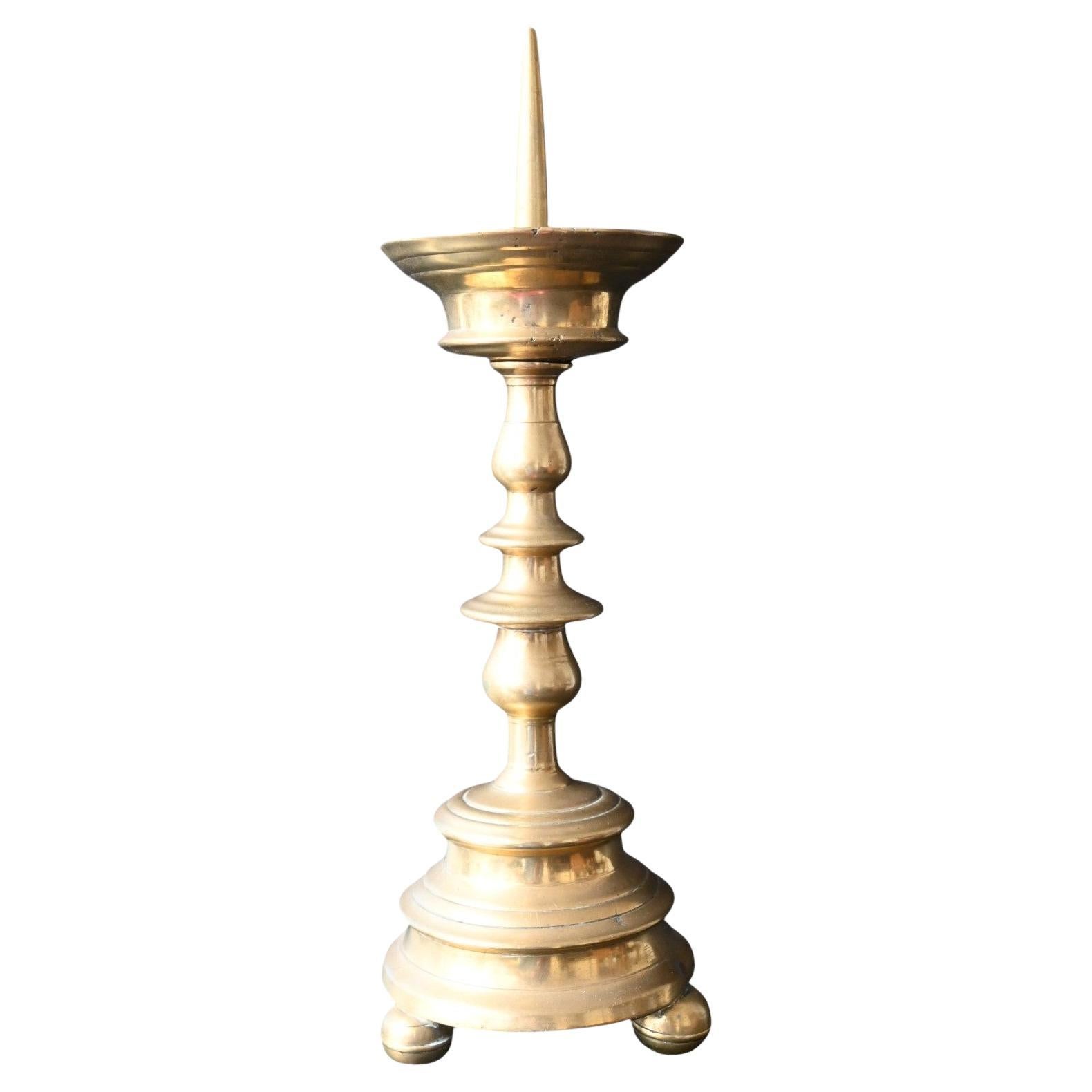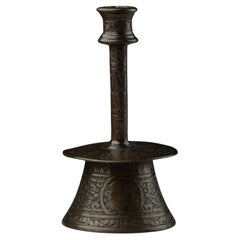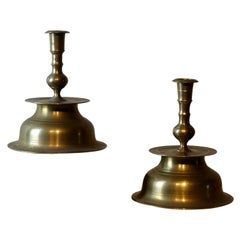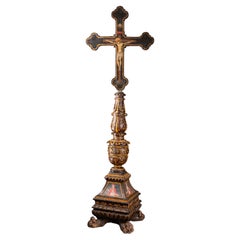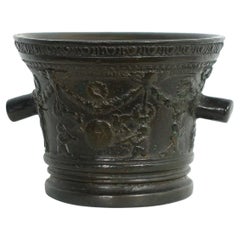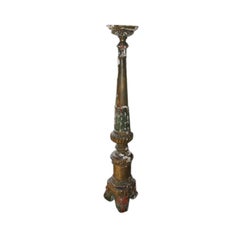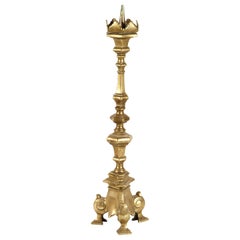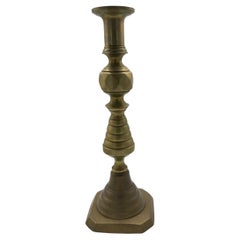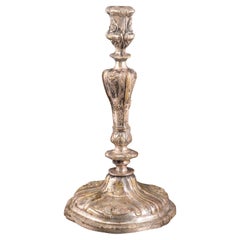Items Similar to Veneto- Saracenic candlestick - 15th century
Want more images or videos?
Request additional images or videos from the seller
1 of 7
Veneto- Saracenic candlestick - 15th century
$10,130.90
£7,501.87
€8,500
CA$13,931.50
A$15,495.41
CHF 8,109.96
MX$188,992.87
NOK 101,904.65
SEK 95,854.48
DKK 64,713.12
About the Item
Veneto- Saracenic candlestick
Engraved bronze
15th century
13 x 8,5 cm
This rare candlestick exemplify exquisite craftsmanship, featuring a bell-shaped base with a flared foot adorned with intricate engraved patterns. The decoration consists of interwoven geometric designs and floral motifs that showcase remarkable precision. Above the base sits a flat, circular platform with slightly downward-curving edges, designed to catch wax drippings. This platform continues the engraved decoration, ensuring a seamless visual flow across the structure.
The stem is richly embellished with intricate bands of decorative motifs, culminating in a hollow opening intended to hold a candle.
The candlestick bear a coat of arms of a rampant wolf in a typical European style: flat at the top and tapering toward the bottom.
Despite their European shape and the inclusion of coats of arms, the decorative elements of these candlesticks are distinctly Mamluk in style. Intended primarily for the Italian market, they are notably smaller than those crafted for a Mamluk clientele, which could be two to three times larger. The candlesticks reflect the technical innovations of Islamic metalworkers, particularly their advanced use of sand-casting for vessels and three-dimensional forms—a method that predated its widespread adoption in Europe by several centuries. These pieces were cast in multiple sections and meticulously assembled to achieve their final form.
The engraved arabesques, thread-like scrolls, acanthus leaves, and palmettes provide a striking contrast to the coats of arms, which is the only Western elements on this object. This combination of Eastern and European influences defines a category of artworks known as Veneto-Saracenic. This term refers to a group of metal vessels produced between the 14th and 16th centuries that blend Middle Eastern craftsmanship with European stylistic features. Initially believed to have been created in Muslim workshops in Venice, these objects are now understood to have been produced in the Near East—particularly Egypt and Syria—specifically for Western clients.
This candlestick serve as rare examples of how Venetian upper bourgeoisie and nobility embraced Orientalist influences during the late Renaissance. The fall of Constantinople in 1453 and the subsequent rise of the Ottoman Empire positioned Venice as the principal commercial ally of Istanbul, the new economic hub of the region. This close relationship undoubtedly influenced Venetian tastes, fostering an appreciation for Orientalist culture.
The group of works known as Veneto-Saracenic testifies to this fascination and cross-cultural exchange, offering a glimpse into the rich artistic dialogue between East and West at a pivotal moment in history.
Bibliography:
Auld, Sylvia. Renaissance Venice, Islam and Mahmud the Kurd: A Metalworking Enigma. London: Altajir World of Islam Trust, 2004.
Carboni, Stefano, ed. Venice and the Islamic World, 828–1797. Exhibition catalogue. New Haven: Yale University Press, 2007.
De Hond, Jan, and Mols, Luitgard. “A Mamluk Basin for a Sicilian Queen.” The Rijksmuseum Bulletin 59, no. 1 (2011): 20, fig. 15.
Dursteler, Eric R. Venetians in Constantinople: Nation, Identity, and Coexistence in the Early Modern Mediterranean.Baltimore: Johns Hopkins University Press, 2006.
Howard, Deborah. “Death in Damascus: Venetians in Syria in the Mid-Fifteenth Century.” Muqarnas 20 (2003): 143–157.
Mack, Rosamond E. Bazaar to Piazza: Islamic Trade and Italian Art, 1300–1600. Berkeley: University of California Press, 2002.
Ward, Rachel, and Susan La Niece. “‘Veneto-Saracenic’ Metalwork: An Analysis of the Bowls and Incense Burners in the British Museum.” In Trade and Discovery: The Scientific Study of Artefacts from Post-Medieval Europe and Beyond, edited by Duncan R. Hook and David R. M. Gaimster, Occasional Paper 109. London: British Museum Press, 1995
- Dimensions:Height: 4.34 in (11 cm)Diameter: 3.35 in (8.5 cm)
- Style:Renaissance (Of the Period)
- Materials and Techniques:Bronze,Engraved
- Place of Origin:
- Period:
- Date of Manufacture:15th century
- Condition:Wear consistent with age and use.
- Seller Location:Bruxelles, BE
- Reference Number:1stDibs: LU6666243873172
About the Seller
5.0
Vetted Professional Seller
Every seller passes strict standards for authenticity and reliability
1stDibs seller since 2022
15 sales on 1stDibs
Typical response time: 1 hour
- ShippingRetrieving quote...Shipping from: Bruxelles, Belgium
- Return Policy
Authenticity Guarantee
In the unlikely event there’s an issue with an item’s authenticity, contact us within 1 year for a full refund. DetailsMoney-Back Guarantee
If your item is not as described, is damaged in transit, or does not arrive, contact us within 7 days for a full refund. Details24-Hour Cancellation
You have a 24-hour grace period in which to reconsider your purchase, with no questions asked.Vetted Professional Sellers
Our world-class sellers must adhere to strict standards for service and quality, maintaining the integrity of our listings.Price-Match Guarantee
If you find that a seller listed the same item for a lower price elsewhere, we’ll match it.Trusted Global Delivery
Our best-in-class carrier network provides specialized shipping options worldwide, including custom delivery.More From This Seller
View AllVeneto- Saracenic candlestick - 15th century
Located in Bruxelles, BE
Veneto- Saracenic candlestick
Engraved bronze
15th century
12,5 x 6,2 cm
This rare candlestick exemplify exquisite craftsmanship, featuring a bell-shaped base with a flared foot ado...
Category
Antique 15th Century and Earlier Italian Renaissance Chandeliers and Pen...
Materials
Bronze
Pair of Chiseled Candlesticks
Located in Bruxelles, BE
Pair of chiseled candlesticks
plated brass
Germany, probably Nuremberg 17th century
H 12 x (base diameter) 9,5 cm
Very good conditions.
Category
Antique 17th Century German Baroque Chandeliers and Pendants
Materials
Brass
$1,430 Sale Price / set
20% Off
renaissance wooden candelabrum and painted cross - Umbria, 16th century
Located in Bruxelles, BE
Base of a carved wooden candelabrum, polychrome and gilded; cross painted on both sides.
Umbria or Tuscany, 16th century
136 x 43,5 x 30 cm
(The cross and the base of the candelabrum were later assembled)
The base of the candelabrum is intricately carved and adorned with polychrome and gilded finishes. The shafts take on the shape of balusters reminiscent of ancient columns, feature ornate foliage decorations, garlands and winged cherub faces. The feet are crafted in the likeness of lion paws. The base is further embellished with depictions of four saint martyrs, among them Saint Barbara and Saint Catherine of Alexandria. The plasticity of the figures, outlined with strong contour lines, the clear and vibrant colors, are stylistic elements linked to the Umbrian tradition of the sixteenth century.The precisely defined and elegant drawing, along with the clear color palette applied with refined chiaroscuro modulations, became the signature of a style that would leave a lasting mark on the era to come. This is exemplified by a preference for vibrant, multicolored images, accentuated in this case by the use of red and pink in the saint's attire.
A notable addition, introduced later, is a polylobed cross painted on both sides. On one side, the Crucifixion is vividly portrayed:The treatment of the corpus itself is in line with High Medieval practice, emphasizing pathos by showing Jesus dead, his arms sagging from the weight of the body. The upper section displaying a pelican pecks at her breast to feed her young with her own blood; a symbol of the sacrifice of Christ on the cross whose body and blood similarly nourishes the celebrant during Mass.
The lower part depicts Golgotha. On the reverse side, the Resurrection is artistically presented in a Renaissance iconography, reminiscent of the renowned composition painted by Piero della Francesca, now housed in the Civic Museum of Sansepolcro. In terms of composition, with the frontal depiction of Christ holding the banner, this motif became particularly widespread in central Italy, spanning from Tuscany to Umbria throughout the 16th century..
The double-sided construction suggests that it may also have been carried in liturgical processions. In Umbria from the 14th century, the use of portable crosses painted on both sides had become a widespread practice, aimed at satisfying the monastic clientele that had significantly increased following the establishment of new religious communities.
The earliest surviving Tuscan painted crucifix represent Christ as Christus Triumphans, or the “Triumphant Christ” with his head up and eyes open. This form was supplanted in the 13th century with the Christus Patiens, or “Suffering Christ” type who is shown often with his head fallen on his shoulder and his eyes closed, as In our cross. The iconography of the suffering Christ appears to have developed out of a new interest in Christ’s human nature, the development of the feast of Corpus Christi and with increased importance given to the Eucharist. The process of humanizing the figure of Christ reaches its peak with the abandonment of all the previous expressive conventions in favor of more realistic details we can observe in this Crucifix, such as the swollen belly, the arms stretched to the limit of muscle tearing, the body falling heavily forward, the abundant blood on
the wounds, and the cross firmly embedded in the rock of Calvary.
It's worth noting that Renaissance candelabra...
Category
Antique 16th Century Italian Renaissance Figurative Sculptures
Materials
Wood, Giltwood
Bronze Mortar, Tuscany, Second Half of 16th Century
Located in Bruxelles, BE
Bronze mortar with garlands, flowers and putti - Tuscany , second half of 17th century.
Measures: height 10
diameter : 13 cm
Artisans and healers used mortars for grinding food...
Category
Antique 16th Century Italian Renaissance Scientific Instruments
Materials
Bronze
double capital - french, end of 13th century
Located in Bruxelles, BE
Double capital with hook decorations
Grey stone
France, 13th century
Reduced—cut in the back in modern times
H 22 x L 41 x P 20 cm
'Hook' is the name given today to these ornamen...
Category
Antique 15th Century and Earlier French Medieval Architectural Elements
Materials
Stone
Pair of Gothic Columns - Italy, 14th-15th century
Located in Bruxelles, BE
Rare pair of Gothic Columns - Olivetani
Marble
Italy, 14th - 15th century
Heraldic shields on the capitals of the Order of the Olivetani
H 220 et 225 cm x W 25 x D 25 cm
H 86 2/3 & 8...
Category
Antique 15th Century and Earlier Italian Gothic Architectural Elements
Materials
Marble
$77,471 / set
You May Also Like
Large Late 18th Century Italian Candlestick
Located in Napa, CA
Large Italian candlestick from the late 18th Century. Beautifully carved and painted with gold, green and red accents. Has one joint which ...
Category
Antique 18th Century and Earlier Italian Candle Holders
Materials
Paint, Plaster, Wood
18th Century Italian Baroque Pricket Candlestick
Located in San Marino, CA
An Italian Baroque brass pricket candlestick with crenellated hexagonal drip-pan and baluster standard on a spreading base with scroll feet. An imp...
Category
Antique 18th Century Italian Baroque Candlesticks
Materials
Brass
19th Century Candlestick Holder from England
Located in Van Nuys, CA
Step back in time with this captivating 19th Century Candlestick Holder from England. Crafted with meticulous attention to detail, this piece is a testament to the craftsmanship of a...
Category
Antique Early 19th Century Candlesticks
Materials
Metal
$173 Sale Price
40% Off
Candlestick or candle holder. Bronze. 19th century.
Located in Madrid, ES
Candlestick or candle holder. Bronze. 19th century.
Bronze candlestick decorated with vegetal and venerated elements in light relief. Both the base and the axis or balustraded foot w...
Category
Antique 19th Century European Neoclassical Revival Table Lamps
Materials
Bronze, Other
Flemish Bronze Candlestick From The End Of The 16th Century
Located in Bilzen, BE
Heavy Flemish bronze candlestick from the end of the 16th century.
Total height 34 cm, without spike 27.5 cm, base diameter 11.5 cm, weight 2.2 kg.
Category
Antique 16th Century Belgian Renaissance Candlesticks
Materials
Bronze
19th Century French Candle Stick
Located in Delft, NL
An 19th century French candle stick
An bronze with gilt candlestick
The candlestick measures 21 cm high and the foot 10 cm diagonal
The weight is 384 ...
Category
Antique 19th Century French Candlesticks
Materials
Bronze
More Ways To Browse
15th Century Bronze
Italian Renaissance 15th Century
Duncan Antique Furniture
16th Century Cross
16th Century Venetian
Medieval Cross
Wolf Gold
Baltimore Antique Furniture
Istanbul Antique
Ottoman Gold Thread
E Eres
Antique Italian Ottoman
Antique Sicilian
Jans Of London
Bear Ottoman
Middle Eastern Lighting
Antique Metal Press
Large Antique Cross Pendant
